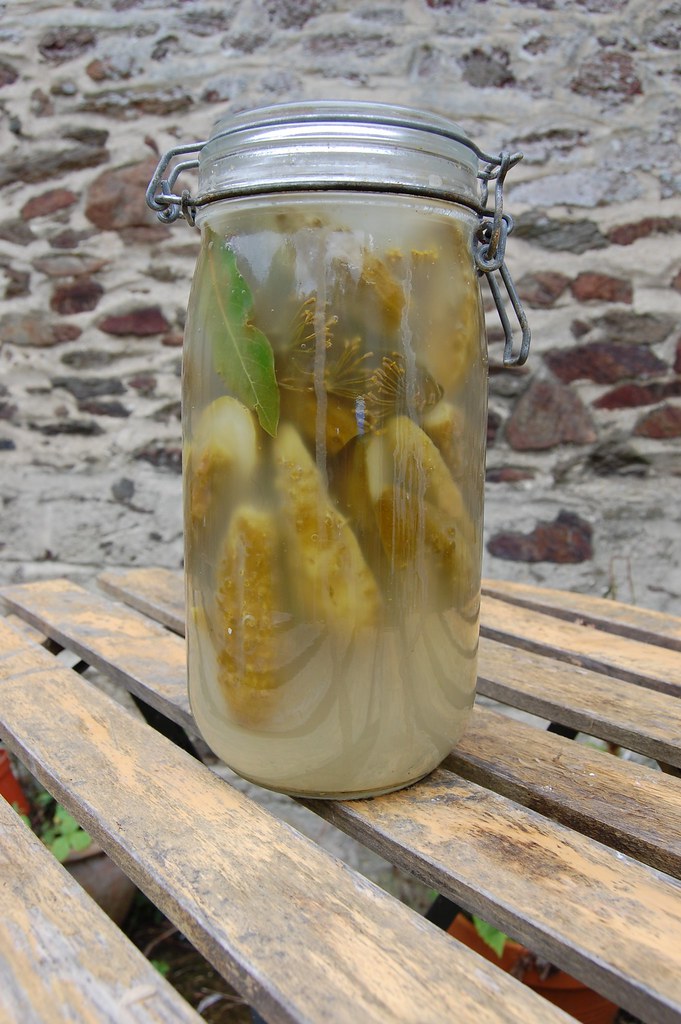
The harvest is really picking up now. This year I'm growing pickling cucumbers. Our usual recipe makes a very strong pickle, sharp with vinegar. It's easy, robust and long lasting but it does make your mouth pucker up. Even if it's in a good way, these very piquant pickles are limited in their uses and not for everyone.
The answer is to make the sort of pickles known as the half sour. These are fermented in brine and their own juices producing a lactic acid cured pickle that is sour without the vinegar strength of brewed condiment. However, making these old fashioned fermented pickles isn't without its difficulties. I've shied away from them in the past because I don't want to die of botulism or have to throw out tubs of foul and rotting vegetables when something goes wrong. Chiding myself for being a wimp, this year I've taken our lives in my hands and made some anyway.
There are plenty of recipes in books and on the web. With the best of my understanding of the science behind it all this is the trial recipe I've made for our first couple of litres of dill cucumbers.
1 litre water
50g sel de guerande
60ml cider vinegar 5%
1 head dill
1 bay leaf
1 grape leaf
grind of mixed pepper and coriander.
Enough small (about 10cm long) pickling cucumbers to fill the jar.
(large ones can be cut into spears if needed)
Make a brine by mixing the cold water with the salt and vinegar. These proportions are quite important, the salt and vinegar work together to allow the beneficial bacteria to reproduce whilst inhibiting the undesirables. The grape leaf also has its part to play in this so include 1 or 2 per litre of brine if you can.
Clean cucumbers thoroughly, paying particular attention to the flower end. Trim a tiny sliver from where the flower was. This is because the enzyme which causes the fruit to decay is in its highest concentration at this point. If you have some bigger fruit divide into smaller sections so that the length and thickness of all the pieces is similar. This makes sure that everything will pickle through at about the same time.
Pack cukes into a 2 litre jar, no rubber ring, interspersing with the leaves and spices. Then fill up with brine. Reserve spare brine for topping up. Close lid and set to ferment. Do not seal the jar. It's important that air can get in. A sealed jar may explode and/or encourage the formation of unpleasant things like botulism spores. You really don't want that.
To hold the cucumbers under the liquid improvise a glass jar or small plate as a weight or use a strong plastic bag filled with brine at the same concentration and sealed as a bung.
Sit the jar in a plastic container in case of spills. After two or three days at room temperature small bubbles will start to form, the liquid will become cloudy and the cucumbers will change to an olive green. Expect to have to clean scum from the top of the jar and from around the weight each day. It's a bit gross but as long as the cucumbers are beneath the brine and nothing starts to smell unpleasant all is well. Add some of your reserved brine as necessary to keep the jar full of liquid.
After five days to a week the pickles will be cured right the way through and if you cut one open there will be no white or 'unpickled' parts visible. You can eat it now!
Clean up the jar, top up again with more brine if necessary and store without air tight sealing in the fridge. The pickles will be at their best after about 10 days and should be finished up within the month. If you want longer keepers it is possible to heat treat them but I'm not the woman to ask about that.
I do find this quite scary but the actual pickles are very nice to eat and I'll be continuing to experiment throughout the summer.